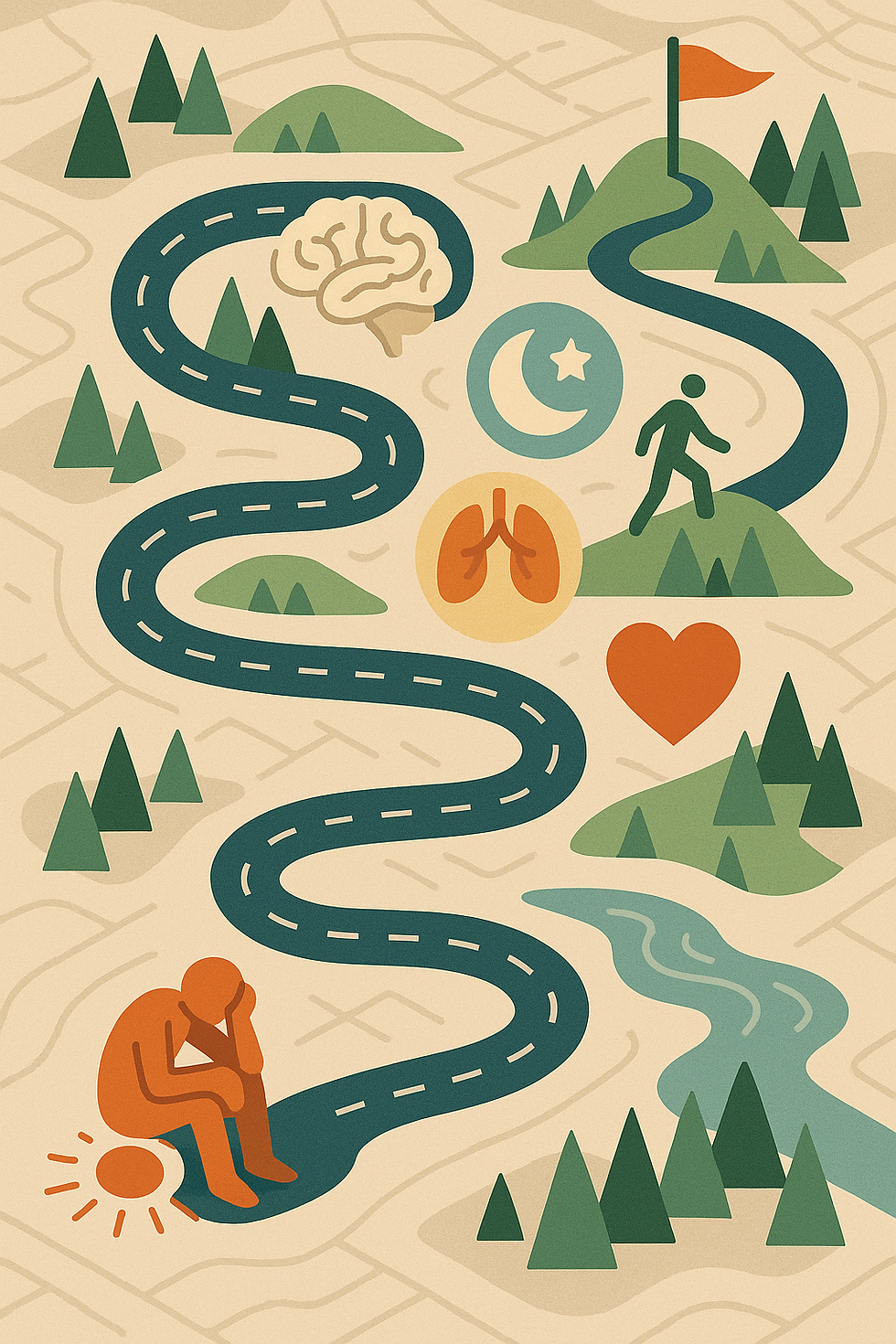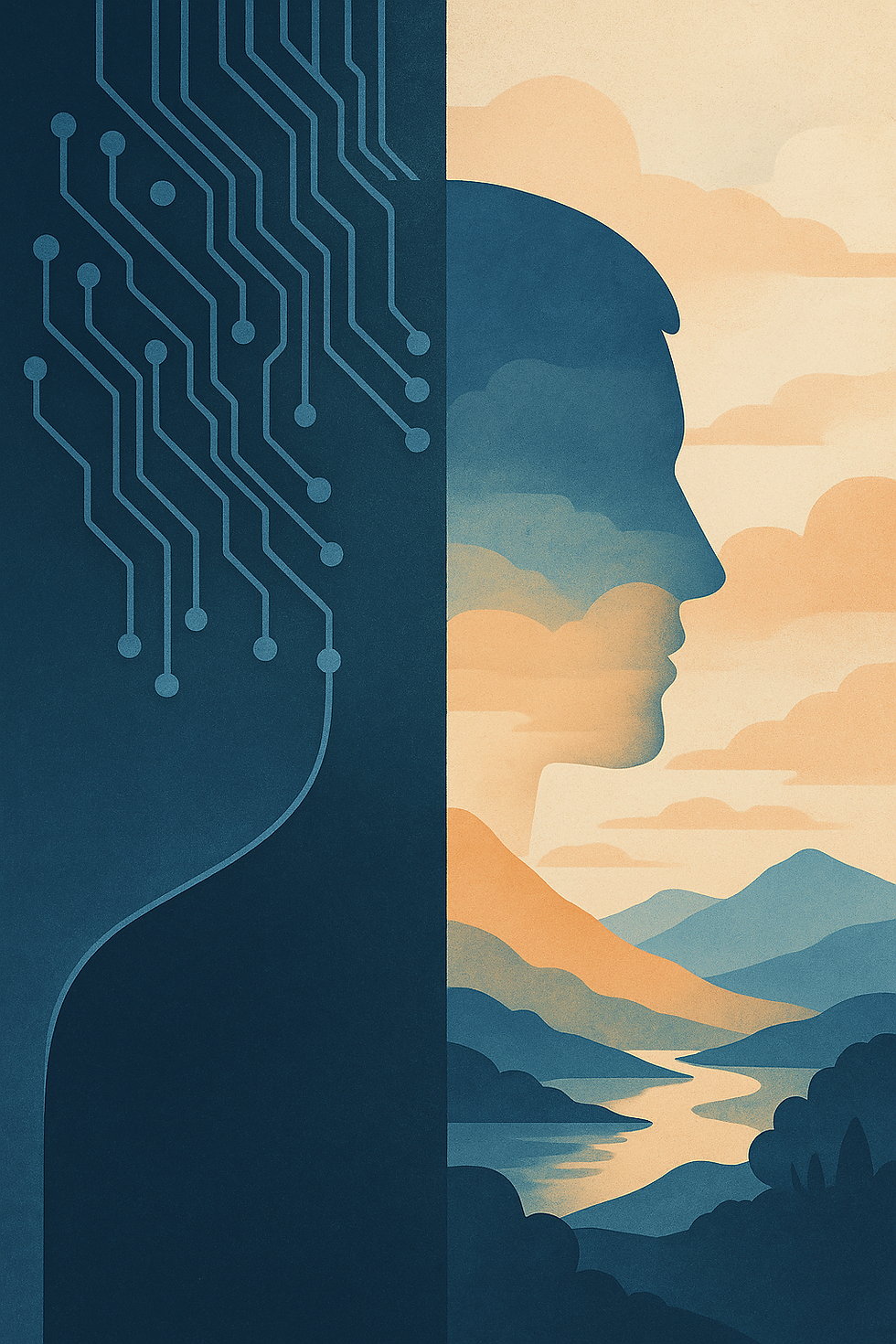How to Be Healthy: What’s the First Step in the Journey?
- John Winston
- Oct 17
- 5 min read
Where does a “health journey” actually start? Almost every time, it begins with self awareness. A desire to be healthier…or a deep desire to just not feel how you’ve been feeling. The path forward may not be clear, but we know with certainty that where we’re at now isn’t where we want to be. Sleep is broken, energy is unstable, moods swing, motivation flickers. From that place, it’s easy to get trapped in cycles of trying harder, whether that’s new workouts, cleaner diets, or stricter schedules, only to crash again.
The common thread isn’t a lack of discipline. It’s a nervous system that never had a chance to stabilize. Health doesn’t begin with doing more. It begins with regulating where we’re at.
This is the paradox at the center of every transformation. Before we can build strength, we have to build safety. That safety starts deep in our body’s hierarchy with the brainstem, circadian rhythm, and the nervous system that sets the tone for everything else.

The Myth of the Perfect Starting Point
Ask ten people where to begin a health journey, and you’ll likely get ten answers: nutrition, fitness, mindset, routine, detox, supplements, or some other start line. Each has truth to it but isn’t the full picture.
The reason there’s no universal starting point is because health isn’t linear. It’s layered. The body is a self-organizing system where higher-order processes, such as emotional regulation, motivation, or focus, depend on lower-order stability.
Aypex is built around the following psychophysical health model consisting of seven pillars:
Neuroregulation (sleep and nervous system stability)
Metabolic stability (energy and nutrition)
Respiratory and interoceptive awareness (breath and body connection)
Movement and load (musculoskeletal resilience)
Emotional regulation and cognitive reframing
Social coherence (belonging and relationships)
Purpose and self-actualization
Every pillar matters, but if someone’s system is deeply unhealthy (i.e. burnout, metabolic chaos, chronic stress) there’s one place biology insists we start: neuroregulation.
Neuroregulation is the Root of Roots
When the nervous system is unstable, everything downstream is reactive. Sleep becomes fragmented, the body oscillates between hypervigilance and apathy, and daily stressors feel like emergencies. It’s not weakness; it’s the brainstem doing its job and keeping us alert when safety feels uncertain.
The tricky part is that dysregulation feels normal when it’s been chronic. The body adapts to chaos as if it’s homeostasis. We might not even realize that our “normal” energy is actually fatigue masked by a cocktail of hormones. Regulation begins by re-establishing rhythm.
Same wake time every morning (±30 minutes), light exposure within the first hour of waking (if possible), and a consistent wind-down cue before bed. These micro-anchors retrain the suprachiasmatic nucleus, which is our body’s internal clock, to release melatonin and cortisol in proper sequence.
Within weeks, we start noticing subtle shifts. Focus returns. Cravings normalize. We begin to wake up actually rested rather than exhausted and groggy. It’s not a mindset trick. It’s neurobiology finding its rhythm again. Stability precedes strength. Sleep and circadian rhythm aren’t luxuries; they’re command centers for regulation.
Energy Before Effort
Once the nervous system has a rhythm, the next bottleneck is energy. A brain without fuel can’t regulate emotions, decisions, or effort. The prefrontal cortex, which is the region responsible for restraint and foresight quite literally powers down when glucose availability is low.
Poor glycemic control, dehydration, and micronutrient deficits mimic anxiety and depression. They also amplify reactivity. That’s why someone might feel “emotionally fragile” when what’s really happening is low blood sugar or electrolyte imbalance. Energy metabolism is our body’s regulatory currency.
The goal here is predictable energy delivery, not the perfect diet. Three real meals per day. Protein at each one. Sufficient sodium, magnesium, and potassium. Hydration that keeps plasma volume steady (i.e. pee that isn’t yellow…Look up the pee chart!). When energy becomes reliable, so does mood. That’s when consistency starts to feel possible rather than forced. We can’t outthink a starved brain. Regulation runs on energy.
Breath and Interoception
Before movement, there is awareness. When the body has been neglected or numbed for an extended period of time, its signals fade into static. We lose the ability to sense hunger, fatigue, or tension until they become extreme. Breath is how we reestablish that connection.
Breathing is both voluntary and automatic, which provides a unique window into our nervous system. Slow nasal breathing (4–6 breaths per minute) lowers sympathetic tone and heightens interoceptive awareness, which is the brain’s ability to sense internal state. This awareness isn’t about control; it’s about conversation. Listening to our own biology rather than overriding it.
As CO₂ tolerance improves, so does emotional tolerance. The same circuits that interpret our need for air also process stress. When breath slows, the body learns safety again. Utilizing our breath may seem deceptively simple, but is biology’s bridge between mind and body. Awareness precedes transformation.
Movement: From Fragility to Feedback
Only once the system is fueled and aware does structured movement become medicine.Too soon, and exercise acts as another stressor. Done in sequence, it becomes the body’s confirmation that it’s safe to be itself again.
Low-intensity movement like walking, mobility work, and light resistance training signals the hypothalamus to recalibrate stress thresholds. Mitochondria multiply. Insulin sensitivity improves. The nervous system learns to handle strain without overreacting.
This is the redefinition of resilience: Resilience isn’t the suppression of stress but precision in response to it. Movement teaches that precision. Exercise doesn’t fix dysregulation. It allows us to work through it. Stabilize first, then move with intention.
Emotion, Connection, and Meaning
When the lower pillars begin to synchronize, the higher ones unlock almost naturally. Emotional regulation returns as the prefrontal cortex re-engages. Therapy, journaling, or mindfulness, possibly tools that once felt futile, start to work because the body can finally integrate their effects.
Social coherence follows. Humans regulate through proximity. Even one safe connection a day reduces cortisol and inflammation. Belonging leads to physiological calibration. From that coherence, meaning starts to emerge. Not as an abstract ideal, but as a felt sense of vitality and an alignment between effort and purpose. These upper pillars sustain what the lower pillars create.
Purpose isn’t a goal at the end of the road. It’s the byproduct of systems in sync.
The Sequence That Holds It All Together
When viewed through this psychophysical hierarchy, health stops looking like a list of habits and starts resembling an ecosystem. Each pillar supports the next:
Sleep and nervous system stability → metabolic energy → breath and interoception → movement → emotion → connection → purpose.
The order matters, not as dogma, but as design. A dysregulated nervous system can’t process nutrition efficiently. An underfed brain can’t manage emotions. A disconnected body can’t sustain movement. Each step becomes possible only when the one below it holds.
That’s why the “starting point” of health isn’t a supplement or a sprint. It’s rhythm. Rhythm is what our body recognizes as safety, and safety is what unlocks adaptation.
Framing How to Be Healthy
The first step in how to be healthy is not heroic, it’s humble. It’s the decision to restore consistency before intensity.To trust that small shifts create big transformations.
Once our system stabilizes, progress accelerates because our biology finally agrees with our ambition. Health starts with rhythm, and from rhythm, everything else becomes possible.
References
McEwen, B. S. (2006). Protective and damaging effects of stress mediators: Central role of the brain. Dialogues in Clinical Neuroscience, 8(4), 367–381.
Walker, M. P. (2017). Why We Sleep: Unlocking the Power of Sleep and Dreams. Scribner.
Sterling, P., & Eyer, J. (1988). Allostasis: A new paradigm to explain arousal pathology. In Handbook of Life Stress, Cognition, and Health.
Craig, A. D. (2002). How do you feel? Interoception: The sense of the physiological condition of the body. Nature Reviews Neuroscience, 3(8), 655–666.
Sapolsky, R. M. (2004). Why Zebras Don’t Get Ulcers. Henry Holt & Company.
Karatsoreos, I. N., & McEwen, B. S. (2011). Psychobiological allostasis: Resistance, resilience, and vulnerability. Trends in Cognitive Sciences, 15(12), 576–584.





